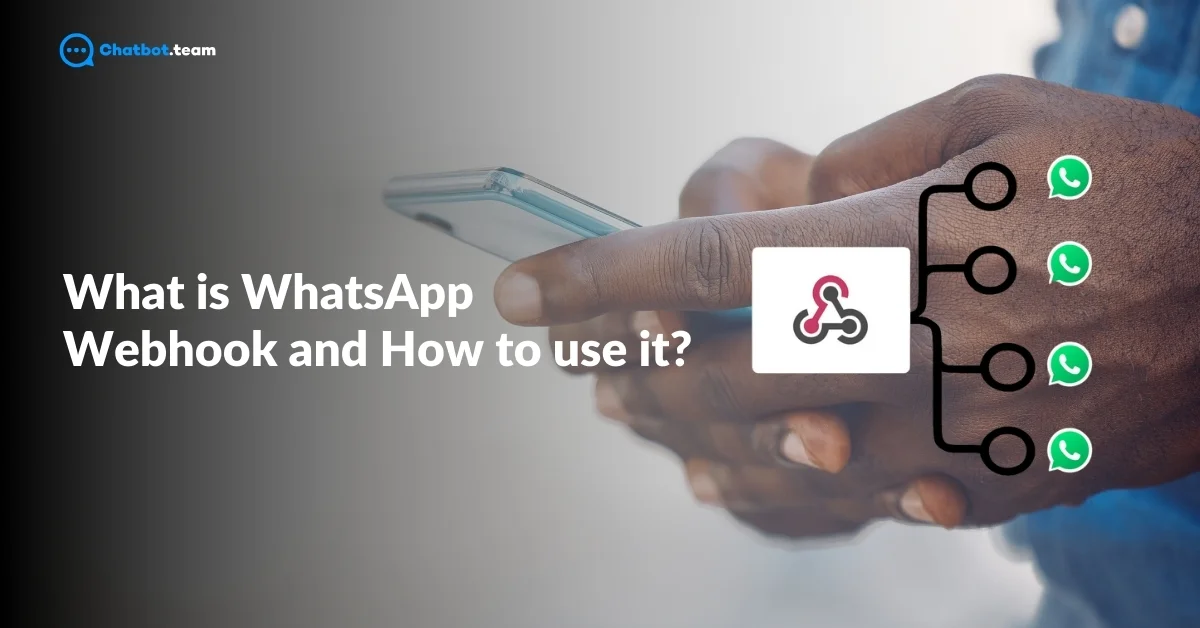Every second, over 100 billion messages are exchanged on WhatsApp. That’s more than 1.15 million messages per second! This isn’t just a number for businesses—it’s an opportunity. But how do you ensure real-time communication, instant updates, and seamless automation in a platform handling such massive volumes of data? This is where WhatsApp Webhooks come in.
These powerful tools act as real-time messengers between WhatsApp and your system, instantly notifying you whenever an event occurs—a new message, a status update, or a customer inquiry. Imagine never missing an important customer interaction, automating order confirmations, or responding to queries instantly without lifting a finger. Webhooks make this possible, enabling businesses to create highly responsive, automated workflows that enhance customer experience.
In this blog, you’ll discover everything about WhatsApp Webhooks—what they are, how they work, why they’re essential for modern businesses, and how to set them up effortlessly. By the end, you’ll understand WhatsApp Webhooks and be equipped to use them effectively to optimize engagement and drive business growth.
What are WhatsApp Webhooks?
WhatsApp Webhooks are automated notifications that help you stay updated about real-time events on your WhatsApp Business account. Imagine receiving a message from a customer or a lead and being notified instantly without having to manually check your WhatsApp account all the time. Webhooks bridge your WhatsApp interactions and other systems, making it easier to respond, track, and automate certain processes.
Here’s how it works: when a specific event occurs on WhatsApp (like receiving a new message, a reply from a customer, or a delivery update), the webhook instantly sends that information to a server or app of your choice. This could be your CRM, email marketing tool, or any system where you want to manage and follow up with leads. The data is sent in real-time, meaning you don’t have to wait or manually update your system.
For example, let’s say someone sends you a query through WhatsApp. The webhook can send that message directly to your CRM system, update the customer’s profile, and even trigger a follow-up message automatically. This helps you stay on top of your leads and improves response times, making the entire process more efficient.
In short, WhatsApp Webhooks make your lead generation and customer communication seamless by automating tasks and allowing systems to “talk” to each other in real-time. They save time, eliminate manual tasks, and ensure no lead or customer inquiry is missed. This makes webhooks an essential tool for any business looking to streamline their operations and grow their audience through WhatsApp.
Why Do We Need WhatsApp Webhooks?
In today’s digital marketing landscape, businesses need tools that help them stay connected with customers, automate workflows, and respond to inquiries in real time. This is where WhatsApp Webhooks come in. They allow businesses to seamlessly integrate WhatsApp into their marketing and lead generation processes by automating notifications and data sharing between WhatsApp and other platforms like CRMs, email tools, or customer support systems.
But why exactly do we need WhatsApp Webhooks? Let’s break down the key reasons:
1. Instant Notifications for Better Response Time
With webhooks, you get real-time updates whenever something happens on your WhatsApp Business account, such as when a customer sends a message or responds to a query. These instant notifications allow you to respond quickly, which is essential for improving customer satisfaction and closing leads faster.
2. Automation of Repetitive Tasks
Instead of manually tracking every message or lead, webhooks can automate tasks like sending confirmation messages, updating CRM records, or triggering follow-up actions. This saves time and ensures that nothing slips through the cracks. For more insights into WhatsApp automation, check out our article on WhatsApp Automation: How it Works + 10 Great Examples.
3. Improved Lead Management
When a potential customer contacts you on WhatsApp, webhooks can automatically send their information to your CRM system. This ensures your lead management process is smooth, organized, and efficient, allowing you to follow up with leads promptly.
4. Seamless Integration with Other Tools
Webhooks allow WhatsApp to communicate with other software you may already be using, such as marketing automation platforms, support ticketing systems, or email marketing tools. This helps create a unified and streamlined workflow, ensuring all your data syncs across different platforms.
5. Enhanced Customer Experience
When your business is responsive and organized, your customers notice. Automated responses, faster communication, and personalized follow-ups improve the customer experience, leading to better retention rates and more conversions.
6. Reduced Manual Workload
By automating notifications and data transfers, webhooks significantly reduce the amount of manual work involved in keeping track of customer interactions. This frees up time for your team to focus on more valuable tasks, like building customer relationships or improving marketing strategies.
7. Increased Lead Conversion Rate
Speed matters when it comes to lead conversion. The faster you can respond to inquiries and follow up with potential customers, the higher the chances of converting them. Webhooks allow for immediate interaction, ensuring that leads are nurtured immediately.
8. Scalability
As your business grows, so does the number of customer interactions. Webhooks can automatically handle large volumes of data and requests, ensuring that your communication and lead generation processes remain efficient, even as you scale.
WhatsApp Webhooks are essential for businesses looking to enhance their communication, lead management, and customer experience. They automate tasks, provide real-time updates, and integrate seamlessly with other tools, making them a powerful addition to any business using WhatsApp for lead generation. By leveraging WhatsApp Webhooks, you can improve response times, streamline workflows, and ultimately increase your chances of converting more leads into customers.
How to Use WhatsApp Webhooks Using Chatbot.team
If you want to take full advantage of WhatsApp Webhooks and make your lead generation process more efficient, a tool like Chatbot.team is a great choice. Chatbot.team allows you to easily integrate and set up WhatsApp Webhooks without needing advanced technical skills. This means you can automate interactions, update your CRM, and streamline communication with potential leads in real-time.
Let’s go through a detailed, NLP-friendly guide on how to set up and use WhatsApp Webhooks with Chatbot.team, step-by-step.
Step-by-Step Instructions to Use WhatsApp Webhooks Using Chatbot.team
Step 1: Sign Up for a Chatbot.team Account
The first step is to create an account on Chatbot.team. If you haven’t registered, simply visit their website and sign up. The registration process is straightforward and takes only a few minutes.
- Go to the Chatbot.team homepage.
- Click on Sign Up or Get Started.
- Enter your email and set a password.
- Confirm your email to complete the registration.
Once registered, you’ll be taken to your dashboard, where you can start setting up your WhatsApp Webhooks.
Step 2: Connect Your WhatsApp Business Account
After logging in, you can link your WhatsApp Business account with Chatbot.team. This integration is essential as it allows the platform to monitor and interact with your WhatsApp messages.
- In your dashboard, go to the Integrations section.
- Choose WhatsApp from the list of available integrations.
- Follow the prompts to connect your WhatsApp Business API. You’ll need to provide your WhatsApp phone number and verify it.
- Once connected, you’re ready to start setting up webhooks.
Step 3: Create a New Webhook
Now that your WhatsApp account is linked, creating a webhook is time. This step will allow you to trigger actions when specific events occur on your WhatsApp account, like receiving a new message or customer response.
- Go to the Webhooks section in the dashboard.
- Click on Create Webhook.
- Name your webhook something simple like “Lead Generation Webhook” so you can easily identify it later.
- Choose the type of event for which you want to trigger the webhook. For example:
- New Message Received: If you want a webhook to trigger every time a new message arrives.
- Customer Reply: If you want the webhook to activate when a customer responds to a message.
Step 4: Define the Webhook URL
The Webhook URL is the destination where the information will be sent. This is typically your CRM or marketing automation tool. When a webhook is triggered, it sends data (such as a new message or lead details) to this URL.
- Enter the Webhook URL. This could be your CRM system, email platform, or any other tool that accepts webhook data.
- Set up the data format that will be sent (e.g., JSON, XML). Chatbot.team makes it easy by pre-configuring common formats.
- Test the webhook by sending a sample message or lead data to ensure everything is set up correctly.
Step 5: Test the Webhook
Before going live, it’s important to test your webhook to ensure it functions properly. You don’t want to miss any leads due to setup errors!
- Go to the Testing section within Chatbot.team.
- Send a test message from your connected WhatsApp account.
- Check if the data is being sent to your Webhook URL successfully. You should see the message details or lead information in your CRM or chosen platform.
If everything works as expected, you’re ready to launch!
Step 6: Automate Your Lead Generation Workflow
Once your webhook is active, you can use Chatbot.team to automate tasks, like sending follow-up messages or updating lead records. Here’s how:
- Set up automation rules within Chatbot.team based on specific triggers. For example:
- When a lead sends a message, automatically send them a thank-you response.
- Trigger a follow-up message if the lead hasn’t replied within 24 hours.
- Use the data from the webhook to customize messages and responses, making your communication more personalized and effective.
Step 7: Monitor and Optimize Your Webhook
Once the webhook is live, it’s important to monitor its performance. This helps you spot any issues early and optimize the workflow as needed.
- Regularly check your Chatbot.team dashboard for insights. You can see how many webhooks were triggered, the messages sent, and any errors.
- Adjust the event triggers or the destination URL to fine-tune your lead generation process if necessary.
Conclusion
WhatsApp Webhooks are the key to real-time automation, instant updates, and seamless customer interactions. Whether you’re handling order confirmations, chatbot responses, or tracking user engagement, Webhooks ensure that your business stays responsive and efficient. With over 2 billion active users on WhatsApp, leveraging Webhooks isn’t just an advantage—it’s a necessity for businesses that want to scale.
By now, you understand WhatsApp Webhooks, how they work, and how to integrate them effectively. The next step? Put them into action. Start automating, optimize your workflows, and enhance customer engagement effortlessly. If you have questions or need help setting up, comment—we’re here to help!


